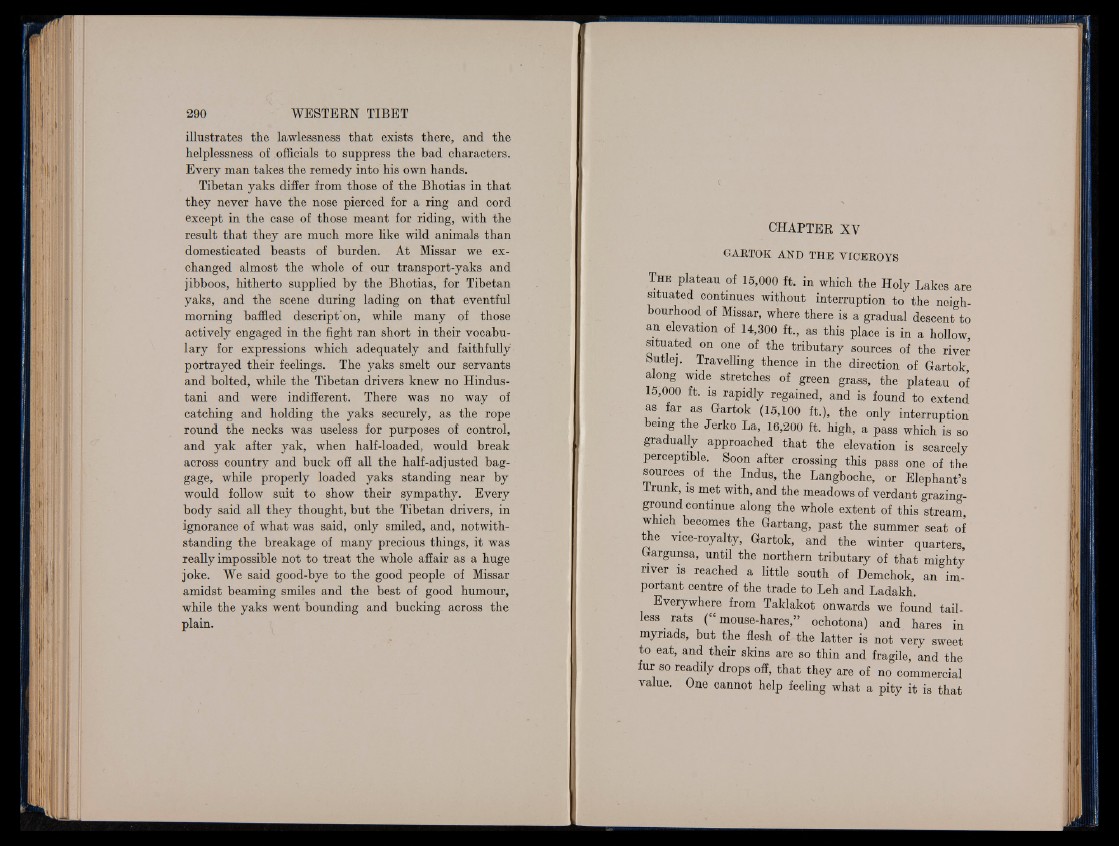
illustrates the lawlessness that exists there, and the
helplessness of officials to suppress the bad characters.
Every man takes the remedy into his own hands.
Tibetan yaks differ from those of the Bhotias in that
they never have the nose pierced for a ring and cord
except in the case of those meant for riding, with the
result that they are much more like wild animals than
domesticated beasts of burden. At Missar we exchanged
almost the whole of our transport-yaks and
jibboos, hitherto supplied by the Bhotias, for Tibetan
yaks, and the scene during lading on that eventful
morning baffled descript'on, while many of those
actively engaged in the fight ran short in their vocabulary
for expressions which adequately and faithfully
portrayed their feelings. The yaks smelt our servants
and bolted, while the Tibetan drivers knew no Hindustani
and were indifferent. There was no way of
catching and holding the yaks securely, as the rope
round the necks was useless for purposes of control,
and yak after yak, when half-loaded, would break
across country and buck off all the half-adjusted baggage,
while properly loaded yaks standing near by
would follow suit to show their sympathy. Every
body said all they thought, but the Tibetan drivers, in
ignorance of what was said, only smiled, and, notwithstanding
the breakage of many precious things, it was
really impossible not to treat the whole affair as a huge
joke. We said good-bye to the good people of Missar
amidst beaming smiles and the best of good humour,
while the yaks went bounding and bucking across the
plain.
CHAPTER XV
GARTOK AND THE VICEROYS
The plateau of 15,000 ft. in which the Holy Lakes are
situated continues without interruption to the neighbourhood
of Missar, where there is a gradual descent to
an elevation of 14,300 ft., as this place is in a hollow,
situated on one of the tributary sources of the river
Sutlej. Travelling thence in the direction of Gartok
along wide stretches of green grass, the plateau of
15,000 ft. is rapidly regained, and is found to extend
as far as Gartok (15,100 ft.), the only interruption
being the Jerko La, 16,200 ft. high, a pass which is so
gradually approached that the elevation is scarcely
perceptible. Soon after crossing this pass one of the
sources of the Indus, the Langboche, or Elephant’s
irunk, is met with, and the meadows of verdant grazing-
ground continue along the whole extent of this stream,
which becomes the Gartang, past the summer seat of
the vice-royalty, Gartok, and the winter quarters,
Gargunsa, until the northern tributary of that mighty
river is reached a little south of Demchok, an important
centre of the trade to Leh and Ladakh.
Everywhere from Taklakot onwards we found tailless
rats (“ mouse-hares,” ochotona) and hares in
myriads, but the flesh of the latter is not very sweet
to eat, and their skins are so thin and fragile, and the
fur so readily drops off, that they are of no commercial
value. One cannot help feeling what a pity it is that